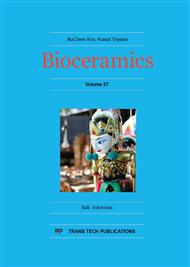[1]
Christopher G (2002) Bone-grafting and bone-graft substitutes. J Bone Joint Surg 84: 454-464.
DOI: 10.2106/00004623-200203000-00020
Google Scholar
[2]
Moore WR, Graves SE, Bain GI (2001) Synthetic bone graft substitutes. ANZ journal of surgery 71: 354-361.
DOI: 10.1046/j.1440-1622.2001.02128.x
Google Scholar
[3]
Dorozhkin SV (2002) A review on the dissolution models of calcium apatites. Progress in Crystal Growth and Characterization of Materials 44: 45-61.
DOI: 10.1016/s0960-8974(02)00004-9
Google Scholar
[4]
LeGeros RZ (2002) Properties of osteoconductive biomaterials: calcium phosphates. Clinical Orthopaedics and Related Research 395: 81.
DOI: 10.1097/00003086-200202000-00009
Google Scholar
[5]
LeGeros R, Lin S, Rohanizadeh R, Mijares D, Legeros J, (2003) Biphasic calcium phosphate bioceramics: preparation, properties and applications. Journal of Materials Science: Materials in Medicine 14: 201-209.
DOI: 10.4028/www.scientific.net/kem.240-242.473
Google Scholar
[6]
Bohner M (2000) Calcium orthophosphates in medicine: from ceramics to calcium phosphate cements: Injury 31: D37-D47.
DOI: 10.1016/s0020-1383(00)80022-4
Google Scholar
[7]
Gauthier O, Bouler JM, Aguado E, Pilet P, Daculsi G (1998) Macroporous biphasic calcium phosphate ceramics: influence of macropore diameter and macroporosity percentage on bone ingrowth. Biomaterials 19: 133-139.
DOI: 10.1016/s0142-9612(97)00180-4
Google Scholar
[8]
Ripamonti U, Roden L (2010) Biomimetics for the induction of bone formation. Expert review of medical devices 7: 469-479.
DOI: 10.1586/erd.10.17
Google Scholar
[9]
Habibovic P, Yuan H, Van Der Valk CM, Gert Meijer, Clemens A van Blitterswijk, Klass de Groot (2005) 3D microenvironment as essential element for osteoinduction by biomaterials. Biomaterials 26: 3565-3575.
DOI: 10.1016/j.biomaterials.2004.09.056
Google Scholar
[10]
Malard O, Gautier H, Daculsi G (2007) In Vivo Demonstration of 2 Types of Microporosity on the Kinetic of Bone Ingrowth and Biphasic Calcium Phosphate Bioceramics Resorption Key Engineering Materials 361-363: 1233-1236.
DOI: 10.4028/www.scientific.net/kem.361-363.1233
Google Scholar
[11]
Bohner M, Baumgart F (2004) Theoretical model to determine the effects of geometrical factors on the resorption of calcium phosphate bone substitutes. Biomaterials 25: 3569-3582.
DOI: 10.1016/j.biomaterials.2003.10.032
Google Scholar
[12]
Daculsi G, Layrolle P (2004) Osteoinductive Properties of Micro Macroporous Biphasic Calcium Phosphate Bioceramics. Key Engineering Materials 254-256: 1005-1008.
DOI: 10.4028/www.scientific.net/kem.254-256.1005
Google Scholar
[13]
Ripamonti U (1996) Osteoinduction in porous hydroxyapatite implanted in heterotopic sites of different animal models. Biomaterials 17: 31-35.
DOI: 10.1016/0142-9612(96)80752-6
Google Scholar
[14]
Plank C, Eglin D, Fahy N, Sapet C, Borget P, van Osch G, Gentili C, Miramond T, Zöller K, Anton M (2012) Gene activated matrices for bone and cartilage regeneration in arthritis. European Journal of Nanomedicine 4: 17-32.
DOI: 10.1515/ejnm-2012-0001
Google Scholar
[15]
Daculsi G (2015), Smart Scaffolds: the Future of Bioceramic, J Mater Sci: Mater Med (2015) 26: 154.
DOI: 10.1007/s10856-015-5482-7
Google Scholar


